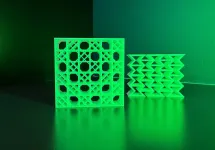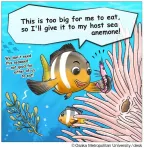(Press-News.org) Inspired by the humble deep-sea sponge, RMIT University engineers have developed a new material with remarkable compressive strength and stiffness that could improve architectural and product designs.
The double lattice design was inspired by the intricate skeleton of a deep-sea sponge known as Venus' flower basket, which lives in the Pacific Ocean.
Lead author of the latest RMIT study into the structure, Dr Jiaming Ma, said extensive testing and optimisation revealed the pattern's impressive combination of stiffness and strength, mixed with an ability to contract when compressed.
It’s this last aspect – known as auxetic behaviour – that opens a whole range of possibilities to apply the design across structural engineering and other applications.
“While most materials get thinner when stretched or fatter when squashed, like rubber, auxetics do the opposite,” Ma said.
“Auxetics can absorb and distribute impact energy effectively, making them extremely useful.”
Natural auxetic materials include tendons and cat skin, while synthetic ones are used to make heart and vascular stents that expand and contract as required.
But while auxetic materials have useful properties, their low stiffness and limited energy absorption capacity limits their applications. The team’s nature-inspired double lattice design is significant because it overcomes these main drawbacks.
“Each lattice on its own has traditional deformation behaviour, but if you combine them as nature does in the deep-sea sponge, then it regulates itself and holds its form and outperforms similar materials by quite a significant margin,” Ma said.
Results published in Composite Structures show with the same amount of material usage, the lattice is 13 times stiffer than existing auxetic materials, which are based on re-entrant honeycomb designs.
It can also absorb 10% more energy while maintaining its auxetic behaviour with a 60% greater strain range compared to existing designs.
Dr Ngoc San Ha said the unique combination of these properties opened several exciting applications for their new material.
“This bioinspired auxetic lattice provides the most solid foundation yet for us to develop next generation sustainable building,” he said.
“Our auxetic metamaterial with high stiffness and energy absorption could offer significant benefits across multiple sectors, from construction materials to protective equipment and sports gear or medical applications,” he said.
The bioinspired lattice structure could work as a steel building frame, for example, allowing less steel and concrete to be used to achieve similar results as a traditional frame.
The structure could also form the basis of lightweight sports protective equipment, bullet proof vests or medical implants.
Honorary Professor Mike Xie said the project highlighted the value in taking inspiration from nature.
"Not only does biomimicry create beautiful and elegant designs like this one, but it also creates smart designs that have been optimised through millions of years of evolution that we can learn from,” Xie said.
Next steps
The team at RMIT’s Centre for Innovative Structures and Materials has tested the design using computer simulations and lab testing on a 3D printed sample made from thermoplastic polyurethane.
They now plan to produce steel versions of the design to use along with concrete and rammed earth structures – a construction technique using compacted natural raw materials.
“While this design could have promising applications in sports equipment, PPE and medical applications, our main focus is on the building and construction aspect,” Ma said.
“We’re developing a more sustainable building material by using our design’s unique combination of outstanding auxeticity, stiffness, and energy absorption to reduce steel and cement usage in construction.
“Its auxetic and energy-absorbing features could also help dampen vibrations during earthquakes.”
The team is also planning to integrate this design with machine learning algorithms for further optimisation and to create programmable materials.
‘Auxetic behavior and energy absorption characteristics of a lattice structure inspired by deep-sea sponge’ is published in Composite Structures (DOI: 10.1016/j.compstruct.2024.118835)
END
Sea sponge inspires super strong compressible material
Inspired by the humble deep-sea sponge, RMIT University engineers have developed a new material with remarkable compressive strength and stiffness that could improve architectural and product designs.
2025-02-26
ELSE PRESS RELEASES FROM THIS DATE:
AI generates playful, human-like games
2025-02-26
While we are remarkably capable of generating our own goals, beginning with child’s play and continuing into adulthood, we don’t yet have computer models for understanding this human ability.
However, a team of New York University scientists has now created a computer model that can represent and generate human-like goals by learning from how people create games. The work, reported in the journal Nature Machine Intelligence, could lead to AI systems that better understand human intentions and more faithfully model ...
Bacteria ‘leaking across stomach lining’ could indicate risk of gastric cancer, new study has found
2025-02-26
A pioneering study has revealed new insights into the role of gastric bacteria in stomach cancer development that could pave the way for a more effective treatment of pre-cancer according to a study published today in Helicobacter.
The Royal Society and Cancer Research UK-funded research led by Dr Amanda Rossiter-Pearson at the University of Birmingham identified a crucial interaction between Helicobacter pylori and non-H. pylori bacteria in the pre-cancerous stage of gastric cancer.
Gastric cancer is the fourth ...
Feeding anemone: Symbiote fish actively feed hosts in wild
2025-02-26
Anemonefish, sometimes called clownfish, have been popular attractions in aquariums ever since Disney’s animated film Finding Nemo arrived in cinemas in 2003. Living symbiotically with sea anemones that shelter them from predators, the fish drive away organisms that nibble at their hosts. Anemonefish have also shown they will provide their hosts with the food given to them by humans, but does this happen in the wild?
An Osaka Metropolitan University Graduate School of Science team led by PhD student Yuya Kobayashi and Professor Satoshi Awata found evidence of this feeding behavior during field experiments. ...
New AI-powered tool could enhance traumatic brain injury investigations in forensics and law enforcement
2025-02-26
A team of researchers from the University of Oxford, in collaboration with Thames Valley Police, the National Crime Agency, the John Radcliffe Hospital, Lurtis Ltd. and Cardiff University, has developed an advanced physics-based AI-driven tool to aid the forensic investigation of traumatic brain injuries (TBI).
The study, published today (26 Feb) in Communications Engineering, introduces a mechanics-informed machine learning framework to help police and forensic teams accurately predict TBI outcomes based on documented assault scenarios.
TBI is a critical public health issue, with severe and long-term neurological consequences. In forensic investigations, determining ...
A protein from tiny tardigrades may help cancer patients tolerate radiation therapy
2025-02-26
CAMBRIDGE, MA -- About 60 percent of all cancer patients in the United States receive radiation therapy as part of their treatment. However, this radiation can have severe side effects that often end up being too difficult for patients to tolerate.
Drawing inspiration from a tiny organism that can withstand huge amounts of radiation, researchers at MIT, Brigham and Women’s Hospital, and the University of Iowa have developed a new strategy that may protect patients from this kind of damage. Their approach makes use of a protein from tardigrades, often also called “water bears,” which are usually less than a millimeter in ...
Double network hydrogel polymers with rapid self-strengthening abilities
2025-02-26
New double network hydrogel technology features automated self-strengthening that rapidly activates upon deformation of its polymer network.
Hydrogels are soft materials consisting of polymer networks and water. They are permeable to substances smaller than their network mesh size and have applications in biomaterials, contact lenses, soft robots, and more. At the molecular level, the cleavage of chemical bonds causes a material to become mechanically weaker and can lead to its destruction. Mechanochemically ...
Schizophrenia is reflected in the brain structure
2025-02-26
The symptoms of schizophrenia vary greatly from person to person. A new study shows how these differences manifest themselves in the structure of the brain.
Schizophrenia is a complex mental health condition that affects perception, thought and emotions. This complexity is reflected in the individual manifestations of the disease: for some patients, perceptual disturbances are the main problem, while for others, cognitive impairments are more prevalent. “In this sense, there is not one schizophrenia, but many, each with different neurobiological profiles,” says Wolfgang Omlor, first author of the study and senior physician at the University Hospital of Psychiatry ...
Researchers warn continuous glucose monitors can overestimate blood sugar levels
2025-02-26
Continuous Glucose Monitors (CGMs) are growing in popularity but new peer-reviewed research, published in The American Journal of Clinical Nutrition, from the University of Bath, suggests they may not be as accurate as many believe. Originally designed to help people living with diabetes manage their blood sugar, these devices are now being used by the health-conscious to track how different foods affect their glucose levels.
The study, from the University’s Centre for Nutrition, Exercise ...
Colorectal cancer: Lipids can predict treatment efficacy
2025-02-26
Colorectal cancer, the second most common cause of cancer-related death, affects almost 2 million people worldwide every year. It is mainly treated with chemotherapy, but its effectiveness decreases over time due to the progressive resistance of tumor cells. A team from the University of Geneva (UNIGE) has identified specific alterations in certain lipids in cancer cells resistant to chemotherapy. These lipid signatures could serve as prognostic markers for understanding resistance to treatment and pave the way for personalized, targeted strategies ...
Physical activity boosts mental health in women with chronic pelvic pain disorders
2025-02-26
New York, NY [February 26, 2025]— A new Mount Sinai study provides compelling evidence that exercise can significantly help the mental well-being of millions of women living with chronic pelvic pain disorders (CPPDs), such as endometriosis and uterine fibroids.
The researchers at the Icahn School of Medicine at Mount Sinai found that activities like brisk walking or aerobic exercise can lead to measurable improvements in mental well-being, regardless of pain levels or history of anxiety or depressive disorders. Their findings were reported in the February 26 online issue of the Journal of Pain Research.
CPPDs affect millions of women worldwide, leading to increased health care ...
LAST 30 PRESS RELEASES:
Mount Sinai Health system receives $8.5 million NIH grant renewal to advance research on long-term outcomes in children with congenital heart disease
Researchers develop treatment for advanced prostate cancer that could eliminate severe side effects
Keck Medicine of USC names Christian Pass chief financial officer
Inflatable fabric robotic arm picks apples
MD Anderson and SOPHiA GENETICS announce strategic collaboration to accelerate AI-driven precision oncology
Oil residues can travel over 5,000 miles on ocean debris, study finds
Korea University researchers discover that cholesterol-lowering drug can overcome chemotherapy resistance in triple-negative breast cancer
Ushikuvirus: A newly discovered giant virus may offer clues to the origin of life
Boosting the cell’s own cleanup
Movement matters: Light activity led to better survival in diabetes, heart, kidney disease
Method developed to identify best treatment combinations for glioblastoma based on unique cellular targets
Self-guided behavioral app helps children with epilepsy sleep earlier
Higher consumption of food preservatives is associated with an increased risk of type 2 diabetes
NTU Singapore-led team captures first-ever ‘twitch’ of the eye’s night-vision cells as they detect light, paving the way for earlier detection of blindness-causing diseases
Global aviation emissions could be halved through maximising efficiency gains, new study shows
Fewer layovers, better-connected airports, more firm growth
Exposure to natural light improves metabolic health
As we age, immune cells protect the spinal cord
New expert guidance urges caution before surgery for patients with treatment-resistant constipation
Solar hydrogen can now be produced efficiently without the scarce metal platinum
Sleeping in on weekends may help boost teens’ mental health
Study: Teens use cellphones for an hour a day at school
After more than two years of war, Palestinian children are hungry, denied education and “like the living dead”
The untold story of life with Prader-Willi syndrome - according to the siblings who live it
How the parasite that ‘gave up sex’ found more hosts – and why its victory won’t last
When is it time to jump? The boiling frog problem of AI use in physics education
Twitter data reveals partisan divide in understanding why pollen season's getting worse
AI is quick but risky for updating old software
Revolutionizing biosecurity: new multi-omics framework to transform invasive species management
From ancient herb to modern medicine: new review unveils the multi-targeted healing potential of Borago officinalis
[Press-News.org] Sea sponge inspires super strong compressible materialInspired by the humble deep-sea sponge, RMIT University engineers have developed a new material with remarkable compressive strength and stiffness that could improve architectural and product designs.





